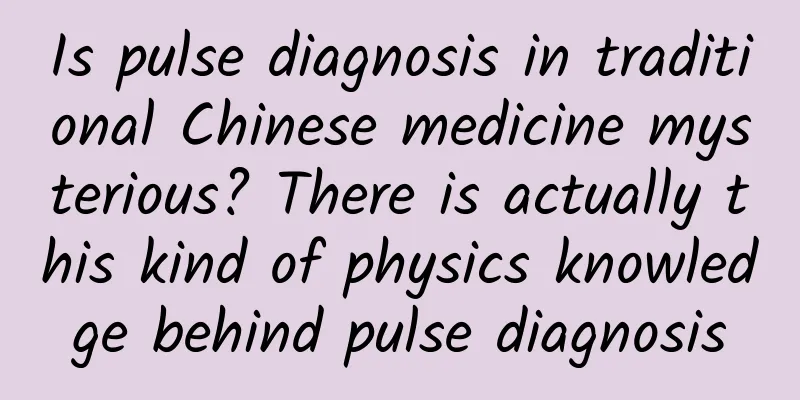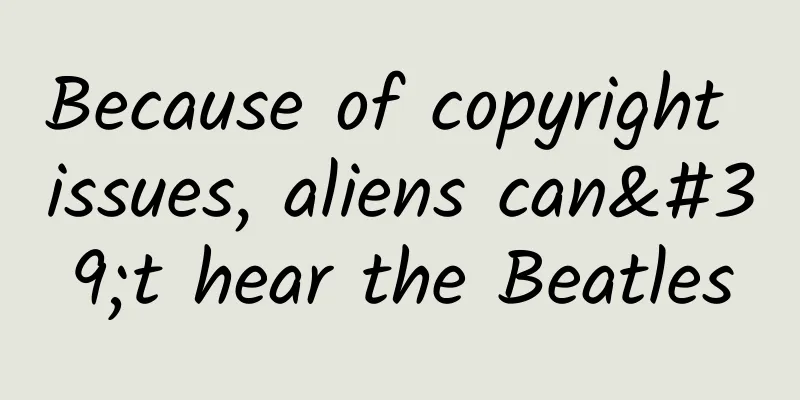Is pulse diagnosis in traditional Chinese medicine mysterious? There is actually this kind of physics knowledge behind pulse diagnosis

|
Source | Institute of Physics, Chinese Academy of Sciences (id: cas-iop) Editor | Xiao Fan If we gently place our hands on our wrists, necks, and chests, we can all feel the faint but firm beating of our heart. That is the rhythm of life. Between heartbeats, the body's metabolism is completed, and people's words and deeds are also powered by energy. All this is so natural that people are used to it. Until one day, I saw a question: Are the heart and wrist pulses simultaneous? My first reaction was, of course, they are simultaneous. Isn't the source of the pulse the heart? Yes, the pulse comes from the heart, which means that the frequency of the heart and the pulse must be the same! However, this also means that the pulse is transmitted from the heart, so there is always a first-come-first-served, and there is always a time delay! According to the wave equation learned in the second grade of elementary school, we know that the upper limit of the speed of mechanical disturbance propagation in matter is the speed of sound. So the problem is solved. It seems that the pulse beats a little bit behind the heart, which is probably the distance divided by the speed of sound. A rough estimate is that there is about 1m of blood vessels between the heart and the wrist, and the speed of sound in water is about 1500m/s. So the delay is about 1/1500 s, or 0.0006 seconds. But I felt something was not right. So I took a closer look! Not only did I find that my estimate was way off, but I also discovered an eye-opening side of the heart. You must have figured out what's wrong, you're so smart! If we treat it as a sound wave and the human body as water, this approximation is as rough as a spherical chicken in a vacuum. As a result, the disturbance should be evenly transmitted throughout the body along the body fluid, that is, the whole person should grow and shrink with the beat of the heart. It's a bit scary to think about it... This also means that we should be able to feel the beating of the heart in every part of the body~ But of course this is wrong! We can only feel this pulsation in the relatively superficial arteries such as the carotid artery and wrist artery. This is reasonable, returning to the essential function of the heart, the function of the heart is to transport blood to the whole body, and the energy of the pulsation should be concentrated on pushing the blood. Schematic diagram of human blood vessels | Image source: Internet But further processing is puzzling. How does the beating of the heart spread? This starts with the mechanism of the heart's function. Do you believe that the role of the heart is to pump blood? In order to better solve the problem of time delay, let's consider this question: How does blood flow to the whole body under the impetus of the heart? Faced with such a question, the image in my mind is this: when the heart beats, it plays the role of squeezing the blood and provides the power for blood flow. In the hard and reliable blood vessels, the blood thus flows steadily. This view is also called the heart as a "blood pump." Schematic diagram of steady laminar flow in a pipe | Image source: Internet Until I saw this point of view: the heart acts more like a pulse wave generator than a blood pump [1]! The pulse wave here refers to the pulsation wave of the artery, and the same applies below. If we take the view that blood flows steadily, a natural contradiction will appear. Since the heartbeat is periodic, how can the blood flow be constant? Well, since the heartbeat is one after another, then we can consider that the speed of blood flow is also periodic, right? That is, blood flows in the blood vessels at a periodic speed in the time domain. Schematic diagram of heart beat | Source: Internet But there is still a problem! Blood is very viscous, and blood vessels are tortuous and complex, with a radius that keeps shrinking from the heart to the limbs. If the blood keeps accelerating and decelerating inside, wouldn't it take a lot of energy to overcome the tube resistance and viscosity dissipation! Where does the problem lie? In fact, we have overlooked a problem: blood vessels cannot be treated as rigid tubes, but are elastic. When the heart beats, the blood vessels will move with it. Blood vessels are constantly expanding and contracting as the heart beats | Image source: Internet The case has been solved. As a result of the heartbeat, the blood vessels expand and contract, causing transverse waves, and longitudinal waves that propagate along the blood. There is an even more surprising fact here: most (almost all) of the energy from the heartbeat is given to the blood vessels to generate pulsation, rather than to push the blood! It seems that the heart is far more than a simple "blood pump" and is more like a generator of arterial pulsation! Heart - Pulse Wave Generator At this point, we have a preliminary picture of the effect of the beating heart on the blood-vessel coupling system. With a concrete physical understanding, it is much easier to pursue a specific mathematical description. Next, we will make a specific estimate to obtain the wave speed. We will find that the properties of blood vessels and blood determine the wave speed. This is of great significance in medicine, biomechanics, and other fields. First, choosing a suitable starting point can greatly simplify the subsequent calculations. For this part of the derivation, please refer to reference [6]. We start from the expression of the sound wave velocity in the medium told by continuous medium wave dynamics: Where is the specific volume, which is the volume per unit mass, and is the inverse of the density. This formula is very applicable and can be used to obtain the speed of sound, etc. The volume compression modulus of the material is the change in pressure when the material is compressed relative to the unit volume. It can be seen that the properties of the material are reflected here. For steel, this amount is large, because even if a large pressure is applied, the volume change of the material can still be ignored. For sponges, this amount is very small, and a sponge can be squeezed into a small piece with very little force. Then, as long as we find the volume compression modulus of the blood-vascular system, we can give a preliminary estimate of the pulse wave velocity! For the coupled system of blood and blood vessels, when faced with a pressure change, we must consider both the volume change of the blood vessels and the volume change of the blood. How is this pressure shared by the blood vessels and the blood? Considering that the blood vessels and blood are in contact with each other in the radial direction, and the pressure change we consider is mainly in the radial direction, we can think that the blood and blood vessels are connected in series like springs: Schematic diagram of blood vessel coupling | Image from [6] We use the subscripts s (system), b (blood), and v (vessel) to identify the entire system, the blood part, and the vessel part, respectively: Among them It's that simple! By finding the bulk compressibility modulus of blood and blood vessels respectively, we can calculate the bulk compressibility modulus of the system and then calculate the wave velocity. For blood, its bulk compression modulus depends on the properties of the blood. It is difficult to derive its value from a more basic perspective for blood with complex components, and it is usually measured experimentally. But for blood vessels, we can approximate them as an elastic material with a bulk modulus of that follows Hooke's law. We generally use bulk modulus to describe solid materials instead of volume compression modulus, because this quantity directly reflects the relationship between stress and strain, and it is easier to find specific values for different materials. Therefore, a little deduction is needed here to convert to . Schematic diagram of vascular stress | Image from [6] What needs to be considered here is the radial response, using the generalized Hooke's law, that is, stress = strain modulus of elasticity. Consider the geometric relationships: Here is the thickness of the blood vessels, so we get: Then convert the infinitesimal element into the infinitesimal element of relative volume change: So we get the vascular volume compression modulus expressed by the bulk elastic modulus Further, we obtain the volume compression modulus of the blood vessel-blood coupling system and define a coefficient: then You are done! As you can see, after adding the blood vessels, the change in the wave velocity of the system is reflected as a multiplication coefficient, which is a function of the ratio of the blood volume compression modulus to the vascular body elastic modulus. Let's look at a few specific examples: (1) Assuming that the blood vessels are rigid (steel tubes), then, Therefore, the wave velocity obtained is equal to the wave velocity of the blood system, which is close to the speed of sound in physiological saline, approximately (2) Imagine that the blood vessels are plexiglass (PMMA) tubes, then, so the speed is greatly reduced. (3) For a real blood vessel system, this ratio is approximately , so we get . As blood vessels become softer and more elastic, the speed of the pulse wave decreases rapidly. The results obtained are also consistent with the actual measured wave speed. Now we can say more accurately in terms of magnitude that the pulse is about one degree later than the heart. If we continue to deduce, we can conclude that the internal energy of blood vessel expansion and contraction is 10,000 times greater than that of blood[1]! In other words, most of the energy of the heartbeat is transmitted along the blood vessels, not the blood. In other words, the heart is more like a "pulse wave generator" than a "pump". Many inspirations It doesn’t matter if you can’t remember the formula. The key is that we discovered the following two facts: 1. The energy of a beating heart is transmitted in the form of a pulse wave, which is a complex wave of fluid-solid coupling. 2. The speed/waveform of the pulse wave and other properties are affected by the properties of blood vessels and blood. The physiological state of blood vessels can reflect many problems! This will lead to new understandings of many issues! In terms of the transport of nutrients: nutrients enter tissues from the blood, and blood flow alone is not enough. In fact, the pulse wave has a waveform like this under the beating of the heart: Schematic diagram of pressure changes during a pulse wave cycle, with the vertical axis representing pressure amplitude. AB corresponds to the ascending branch, and the latter corresponds to the unloading branch. Image from [4] Every time the pulse wave of the heart beats, there will be a rising branch of pressure, followed by a falling branch. Between the rise and fall, the blood flow and the transmission of nutrients are completed. Take oxygen as an example. The percentage of hemoglobin binding oxygen depends on the partial pressure of oxygen in the blood, which is proportional to the total pressure of blood pressure. That is, the oxygen concentration changes with the pressure changes brought by the pulse wave, and oxygen is delivered to various tissues accordingly. This is very different from the intuitive view that oxygen is transported with the steady flow of blood, which also leads to the human body being able to transport at a pulse wave speed (10¹m/s) that is much faster than the blood particle flow rate (10-1m/s). People's efforts on artificial hearts can also deeply reflect the actual role of the heart. Features of artificial heart | Image from [3] When the heart cannot perform its function, an artificial heart may be needed to replace it. When designing artificial hearts, people initially imitated the beating of the heart to obtain the first generation of pulsating pumps, but the resulting devices were large and easily damaged. Later, the second generation of axial flow pumps were obtained from the perspective of promoting blood flow. As a result, in order to achieve the original blood flow effect, a very high speed was required, which easily caused great damage to the effective components of the blood at the artificial heart. Finally, the third generation of magnetic levitation centrifugal pumps solved the problem of blood component damage. However, people have found that the power required to simply push blood flow is far greater than the working power of the heart itself; and the steady flow push method not only cannot effectively deliver nutrients to various tissues and organs, but will also cause cardiovascular tissue to gradually lose elasticity due to the disappearance of pulse waves, and eventually cause serious cardiovascular diseases. The current artificial heart design also needs to produce pulsating blood flow through periodic changes to achieve the original effect of the heart. As we mentioned earlier, the speed and waveform of the pulse wave depend on the mechanical properties of blood vessels and blood. So a natural thought is that the properties of the pulse wave can well reflect the health of the human body! That's right! Cardiovascular and cerebrovascular diseases are the number one killer of humans (far more than cancer), posing a great threat to human health. The pulse wave can reflect the health information of blood vessels to a certain extent [2], for example: Comparison of pulse waves between normal people and those with arteriosclerosis | Image from [7] By measuring the pulse wave pressure changes at different locations, the health of blood vessels can be reflected | Image from [8] In addition, speaking of this, do you think of something? Yes, that is traditional Chinese medicine pulse diagnosis! The pulse pressure wave pulse chart can be connected with the 28 traditional pulse conditions, such as Flat pulse, string pulse and slippery pulse correspond to different pressure pulse diagrams | Image from [5] (The editor has to sigh that he felt the pulse for a long time but didn't feel anything. Can people really feel this kind of waveform difference? The key is really. I heard that students studying traditional Chinese medicine have to practice for a long time on the pulse simulator. I can't help but sigh that every profession has its own specialties.) I won’t introduce it here. Students who are interested can learn more about it~ Waves are so close to us. Every beat of the heart spreads in the form of pulse waves along ultra-flexible blood vessels, allowing nutrients to be efficiently delivered, forming a wonderful movement of life, which makes us sigh at the greatness of life! In the future, we also hope that in-depth research on pulse waves can bring more help to human health. Note: This article does not involve any medical advice, but is only a discussion of biomechanics. Please follow your doctor's advice for any health issues. Cover from [8] References: [1] Wang Hui, Wang Lili, Miao Fuxing, et al. On the “pump theory” and “wave theory” of cardiac function[J]. Explosion and Shock Waves, 2020, 40(11): 4-13. [2] Zhang Jing, Sun Lijuan. Application value of ultra-fast pulse wave technology in atherosclerosis in patients with metabolic syndrome[J]. Anhui Medicine, 2023, 27(10): 2081-2085+2125. [3] The Current State and Future of Artificial Hearts [4] Liu Jian. Pulse waveform quality assessment and quantification in oscillometric blood pressure measurement[D]. Southeast University, 2022. DOI: 10.27014/d.cnki.gdnau.2022.000465. [5] Modern Chinese Medicine Pulse Diagnosis. Beijing: People's Medical Publishing House, 2006 [6] Miao Fuxing, Wang Hui, Wang Lili, et al. Relationship between blood-vessel coupling characteristics and pulse wave propagation characteristics[J]. Explosion and Shock Waves, 2020, 40(04): 4-13. [7] Wang Lili, Wang Hui, Yang Liming, et al. On the crux of the objective and quantitative research of pulse wave[J]. Chinese Journal of Traditional Chinese Medicine, 2017, 32(11): 4855-4863. [8] The Secret of the Human Body: Grasping the Pulse of Life - The Development of Modern Pulse Wave Research This article is reproduced from the official account "Institute of Physics, Chinese Academy of Sciences" (ID: cas-iop) |
Recommend
How to turn users who hate your product into the most loyal ones
During my short 5-year operation career, I spent ...
Several data persistence solutions in iOS: I will remember you forever!
[[141204]] Introduction The so-called persistence...
Honeywell responds to unqualified mask inspection (with original text)
Honeywell responds to unqualified mask sampling (...
Can LeTV X55, the evolution of super TV, become a new benchmark in the industry?
When LeTV first entered the smart TV field, it na...
What is the future of virtual reality? See what Google VR chief describes
Google Cardboard is one of the cheapest virtual r...
Many people don’t know all these things about wine!
Autumn is the season for grape harvest. Grapes ca...
BMW Group Financial Report: BMW Group's revenue in 2024 is 142.38 billion euros, down 8.4% year-on-year
Recently, the BMW Group released its 2024 and Q4 ...
18 Practical Marketing Experiences from Advertising Mad Man Ye Maozhong
Are you worried about how to improve your brand a...
National Day Special: 30 pictures to see the "stunning beauty" of China!
On the land of China The blue color of water and ...
Did Wang Feng make Xiaomi cry at the Meizu press conference on September 23?
On September 23, when you see Wang Feng singing o...
Will the novel coronavirus break out again after the May Day holiday? Does the new virus strain cause conjunctivitis? One article explains it all!
From the surge in the number of positive COVID-19...
Pit and fissure sealing: Let your child's teeth resist "sugar-coated bullets"
After seeing this picture, you must be wondering,...
Dance Steps and Emotions "The Way of Flirting 3 Decoding the Heart" Watermark-free PDF e-book
Dance Steps and Emotions "Teasing 3 Decoding...
A great trick used by all marketing experts!
Everyone should have a few micro-businesses on th...
Fruitwood Wanderer Intermediate and Advanced Guitar Course
Fruitwood Wanderer Intermediate and Advanced Guit...









